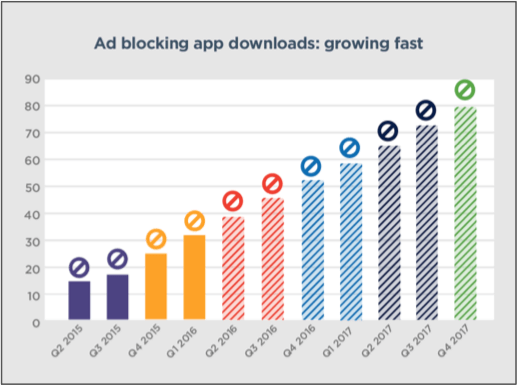
Content blocking has emerged as a potentially serious threat to publishers that rely on advertising. It is estimated that 122 million mobile users in India use ad-blocker browsers, which is nearly two-thirds of the smartphone population.
As a trend, ad blocking is just getting started. So far in 2016, the growth rate of new users downloading and installing mobile ad blockers has more than tripled. If this rate of adoption continues, more than 80% of smartphone owners could be blocking ads by mid to late 2017.
 Industry estimates clearly indicate the growing trend of Ad Blocking, and also give insights into the potential impact on online advertising. TUNE’s report showed that 80% of users, could have the ability to block ads by 2017.
Industry estimates clearly indicate the growing trend of Ad Blocking, and also give insights into the potential impact on online advertising. TUNE’s report showed that 80% of users, could have the ability to block ads by 2017.
What are the publishers doing to stop Ad Blocking?
A couple of weeks ago, Google and AppNexus, two of the largest publishers in the industry severed their ties with Ad Bloker Plus – who is moving to become an “ad exchange” and sell ads that are “acceptable” from people who have installed their software and app.
Facebook also called out the Ad Blocking industry with its new manifesto, which will in essence “make it tough for ad-blocking software to distinguish between a status update and a sponsored ad on the desktop version of the social network” according to their post on August 9th. It will be interesting to see how this plays out in the coming months.
Technically, Ad Blocking is done by generating a honeypot-like URL, verifying its delivery within the DOM HTML model after the web page is rendered by the web browser. The software then verifies if the expected advertising elements are present, removes them, in essence “blocking” them. Detection is also simplified, because most ads are served from an ad server, such as Google DART, Facebook ATLAS, etc. Because they serve these ads from similar ip originations, the ad blocking software can simply try to match those addresses. When a webpage starts loading, the ad blocking application downloaded by a user, looks at the site and its scripts and compares them against a list of sites and scripts it was built to block. If it finds any, it blocks them.
Few interesting ad-blocking trends
Mary Meeker’s 2016 Internet Trends Report indicates an upward accelerating trend in ad-block adoption across desktop and mobile worldwide
In HubSpot’s Global Interruptive Ads Survey (Q4 2015 to Q1 2016), 50% of respondents had already installed AdBlock; more than 60% of adults (18-35 years old) were expected to do so by Q3 2016, with 35+ respondents not that far behind
The recent IAB report on ad blocking found 26% of desktop users block ads online
How Do Ad Blockers Work?
Ad blockers work by identifying and blocking web technologies such as Flash that are used to deliver ads on a webpage, URLs that have been documented as the source of ads (directories such as EasyList or Fanboy actually keep track of advertiser URLs), or behaviours typical of advertising, such as autoplay.
One of the major problems with ad blocking software is that the ads are still served to the web page. This means that an advertiser would still get charged, since to the publisher, they’d served an advertiser’s ad, even though it was blocked by the end user’s application.
Why Block Ads in the First Place?
There are many reasons why people implement ad blocking. Protecting privacy and preventing tracking of their browsing history is one rationale, while another powerful motivating factor is to improve their experience of using the internet. Being ambushed by a pop-up is annoying, while the resource-intensive ads themselves can significantly slow down a web browser, especially on a mobile device. For consumers in Asia, primary reasons for blocking ads include the high expense of data and loading speed.
On top of that, ad networks can face the challenge of inadvertently serving malware. Many consumers believe that installing an ad blocker improves user experience and keeps devices safe from viruses.
Desktop ad blockers, typically browser plugins and extensions, offer a free way for consumers to get rid of online ads. However, one thing many internet users may be unaware of is that ad blockers are run as businesses, and actually make money from advertisers and tracking data. For mobile, numerous ad blocking apps offer consumers the ad-free experience they are looking for.
How Are Ad Blockers Run As a Business?
There are at least four different “flavors” of ad blockers:
- Block everything (for Tips and Donations) – There are some ad blockers that do exactly what you would expect them to do, block everything. Privacy Badger, produced by the non-profit digital rights advocacy group Electronic Frontier Foundation, blocks any tracking considered ‘non-consensual’. This means that Privacy Badger blocks most if not all of the tracking advertisers use for remarketing
- Whitelist… for a Price – Some ad-blocking services will block everything except for “acceptable ads.” For example, Adblock Plus will display ads that meet certain “acceptable” criteria. Publishers that depend on advertising can apply to Adblock Plus to get whitelisted. However, larger entities have to pay 30% of ad revenues. Crystal, a mobile ad blocking app, uses the same tactic
- Freemium Ad Blocking- Other ad blockers offer a freemium ad blocking product. While basic features of the app can be accessed for free, users have to pay in order to get access to a premium version, which provides additional services such as a secure Wi-Fi. Disconnect and 1Blocker are examples of this model
- Cut out advertisers and publishers completely- Ghostery takes a different approach. In exchange for blocking ads and data trackers, Ghostery collects and sells anonymized data about user behaviour. The data is sold (in aggregate) to publishers, advertisers, and others so they can improve the privacy and user experience of their own sites.
Isn’t Whitelisting Ads Extortion?
It is easy for publishers to view ad blocking as an existential threat. By 2017, U.S. digital media companies could lose out on as much as $9.7 billion across digital ad formats. Since no one is willing to view the ads that pay for content, there are fears that ad blocking will undermine the entire infrastructure of the free web.
For publishers, the most troubling part is that some of the most popular ad blocking services will white-list advertising for a price. It all amounts to extortion…or does it?
While certainly, there are many publishers experiencing pain, there are others who are adapting to the new era of ad blocking. These publishers know that ad blockers address two significant pain points experienced by internet users:
- Disruptive, poor quality, and irrelevant ads and
- Intrusive attempts by advertisers to track browsing habits without permission
It is time to get innovative to address the problem of Ad Blocking
Some publishers are getting ahead of the curve by adopting innovative approaches to monetization that focus on quality and relevance. In fact, ad blocking consumers are becoming an attractive target market, providing a great opportunity for advertisers to make their ads better and less interfering.
These strategies include featuring engaging, high-quality native advertising or advertorials that provide value to a reader. Other publishers charge a nominal fee for access to their content and an ad-free experience or block readers from viewing content until the site is whitelisted. A few are even experimenting with monetization strategies that include partnerships with other publishers.
Focus on quality will truly address the interests of your target audience. Ad blocking became popular because the traditional approach to digital monetization is unpopular with online users. If publishers, rather than ad blocking services can address this pain, they’ll thrive in the era of ad blocking.
*
Ashwiny Thapliyal is the Head Consultant for India at TUNE and he helps shape TUNE’s strategy in India. With more than 10 years in the online marketing and ad-tech field he has worked for companies like Infoedge ( Naukri.com, 99acres ), InMobi and Komli Media leading teams across India and SEA. The last 4 years or so have been focussed on the mobile performance side allowing him to be deeply connected with the whole ecosystems of networks, affiliates, brands, agencies etc .





























